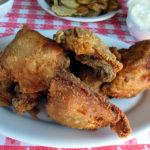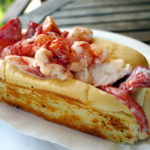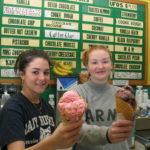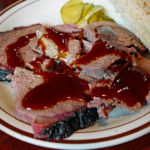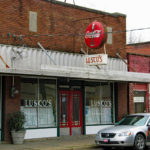Ichiban P. B.
Pacific Beach, San Diego, California, Thursday, 11:05 A.M.: Customers cluster at the door of Ichiban P.B. on Garnet Avenue, waiting for the eatery to open. (Ichiban is Japanese for the number 1 or the word first; P.B. is local shorthand for Pacific Beach.) The featured attraction in the window of the storefront café is a waist-high display case in which are arranged examples of the day's specialties, each labeled with a hand-lettered placard. Exhibits include such fare as mixed sushi and bowls of udon (thick wheat noodles), as well as white plastic trays partitioned to hold multicourse meals. This is not the synthetic food that other Japanese restaurants display; it is real food, imperfectly arranged. A hot halo of sukiyaki mist begins to form on the glass above a bowl of glistening beef, noodles, and rice. On the door, a sign reads CLOSED.
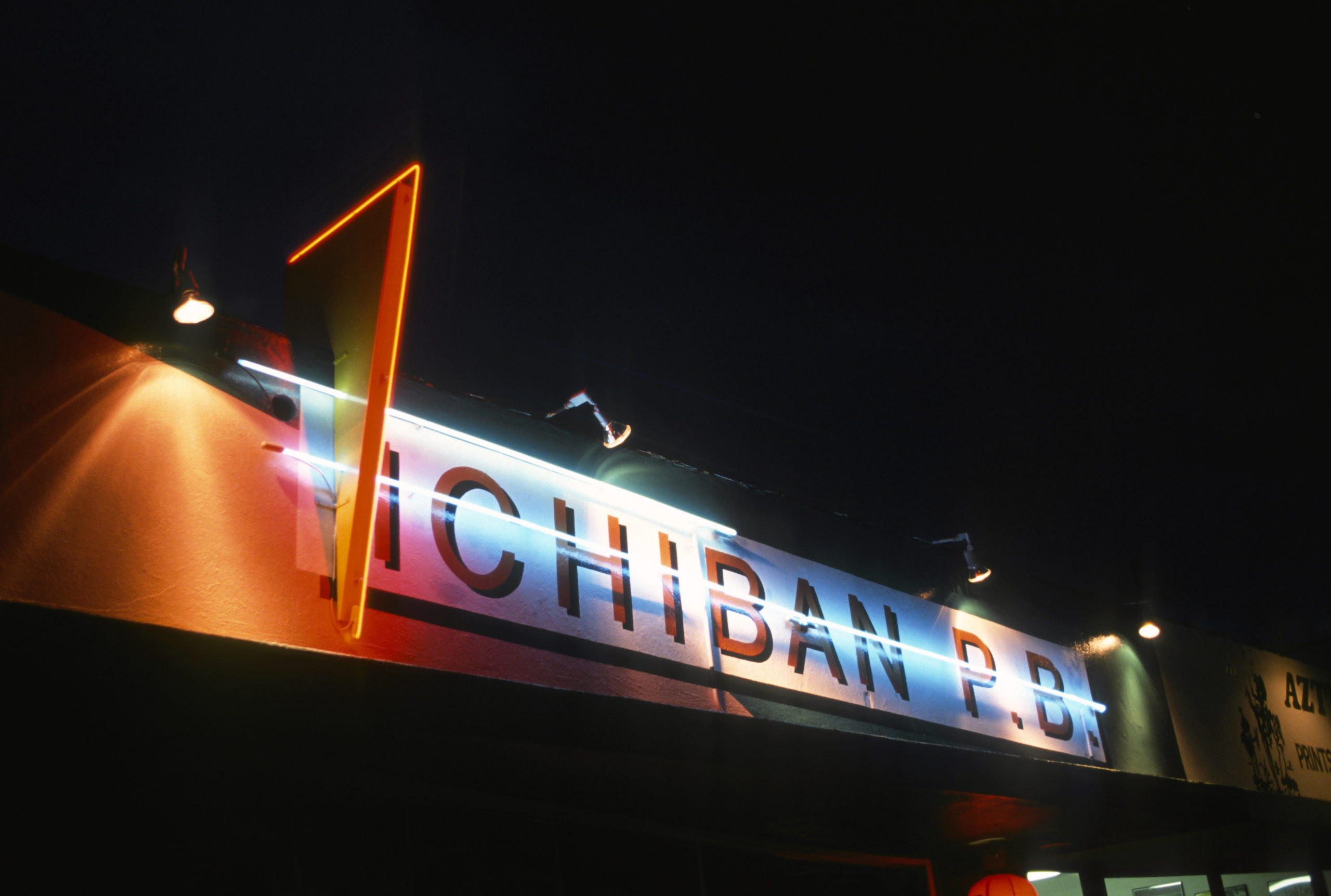
By Jane and Michael Stern
Originally Published 1994 Gourmet Magazine
Pacific Beach, San Diego, California, Thursday, 11:05 A.M.: Customers cluster at the door of Ichiban P.B. on Garnet Avenue, waiting for the eatery to open. (Ichiban is Japanese for the number 1 or the word first; P.B. is local shorthand for Pacific Beach.) The featured attraction in the window of the storefront café is a waist-high display case in which are arranged examples of the day’s specialties, each labeled with a hand-lettered placard. Exhibits include such fare as mixed sushi and bowls of udon (thick wheat noodles), as well as white plastic trays partitioned to hold multicourse meals. This is not the synthetic food that other Japanese restaurants display; it is real food, imperfectly arranged. A hot halo of sukiyaki mist begins to form on the glass above a bowl of glistening beef, noodles, and rice. On the door, a sign reads CLOSED.
Garnet Avenue is a raucous kind of place even at lunchtime, crowded with shoppers and surfers, students toting book bags along the sidewalk and car-crazy show-offs piloting ‘vettes and vans up and down the thoroughfare. But there is something especially excited about the little crowd outside Ichiban P.B. Although a sign makes it clear that lunch begins at 11:15, the dozen or so people gathered look at their watches, pace, study a menu taped to the inside of the window, and occasionally peer into the darkened interior to see if there is any chance Ichiban might open early.
Six of the waiting congregation, five men and a woman who all piled out of one sedan, wear plastic photo-identification cards clipped to their shirts—the kind of IDs people wear in high-security jobs. One of the men is wearing a T-shirt bearing the inscription “Sub-Human.” The sextet are all workers at the United States Navy submarine base in nearby Point Loma.
“We are on a short lunch hour,” the man in the T-shirt announces to the growing crowd of customers. “We need to get in and eat!”
11:09 A.M.: One of the Navy workers leans against the front door, and to everyone’s amazement it swings open. An employee inside calls out, “Six minutes!” The accidental intruder retreats to the sidewalk and continues fidgeting.
11:13 A.M.: The woman in the Navy group, having examined the menu in the window and hovered over a ginger-chicken platter on display, can no longer tolerate the wait. “There are more of us than of them,” she says to her comrades and about twenty other people who have gathered around the door. “Let’s rush the place!” A nervous laugh ripples through the crowd, but chaos is held at bay when an employee inside flips the CLOSED sign so it reads WE’RE OPEN.
At precisely 11:15 A.M. the door swings wide. Ichiban P.B., a community café known to San Diego cognoscenti for its low-cost Japanese-American fare, will be packed with customers by 11:30, and there will be a wait for tables by noon. At night the wait will be a half hour or more; on weekend nights, the line stretches well out onto Garnet Avenue and employees must practice crowd control to keep the sidewalk clear.
What makes this vest-pocket rice parlor so popular? “The food’s good, reasonably priced, and fast—and you always get plenty,” explains a strapping sun worshiper waiting in line one Friday night. Dressed in a black turtleneck and pressed jeans, he is a regular who likes everything on the menu, from pork gyoza (browned steamed dumplings) to octopus sashimi. “The teriyaki is superb,” he says with an epicure’s authority. “The sushi is different from what is served in a regular sushi bar. It is more streamlined, not as ornate. I believe it is easier to eat.”
Sam Yago, the young, Hawaiian-born manager of a nearby surf shop called Pacific Drive, comes to Ichiban five nights a week because he loves the chicken katsu, a crunchy fried cutlet that is served with miso soup and a crisp green salad spiked with citrus-laced ginger dressing. The dressing alone attracts salad lovers who have little interest in either sushi or soba. Sam’s dining partner, an avid surfer, predicts that Sam will live to be a hundred because of his patronage of Ichiban. “Do you think there is a secret ingredient in what they make here?” Sam’s pal wonders, half-jokingly. “It does something for you, body and soul.”
Skip and Leslie Shirley, Friday-night regulars at the sushi bar, believe in the wizardly powers of the kitchen. “This is addictive stuff,” Skip pronounces. When he and Leslie started coming to Ichiban, not long after it opened in the mid-eighties, they ate only teriyaki. “It took me some time before I would order raw fish for a meal,” says Skip, a robust fellow who looks like he enjoys good food. “It is an acquired taste. But after I started with sushi, I graduated to sashimi. Now I don’t want any rice interfering with the fish, which, if it is really fresh, isn’t fishy-tasting at all… and it is always fresh at Ichiban.”
Skip and Leslie always sit at the sushi bar because they like to watch the chefs. Ed Tiongson, Ichiban’s twenty-six-year-old manager, who began working here when restaurateur Fujio Iizuka opened the place, shows us how to make a California roll. It looks easy: Slap down the makizu (bamboo mat), dip your fingers in ice water (so nothing sticks to them), and grab a handful of rice. Pat the rice down on a square of nori (a thin sheet of dried seaweed), add some avocado and crab, and use the makizu to roll everything up into a tidy log. Then slice the log into little wheels. An untrained chef can do it—just as any dilettante can work his way through the Moonlight Sonata on the piano. But when you watch Ed, you are watching a virtuoso.
“I am going to tell you why we love this place,” Skip Shirley says as he delights in the sight of his and his wife’s platters of raw fish taking shape. “You always walk out feeling you’ve had a good deal as well as a good meal.” After polishing off a pair of fifteen-piece sashimi plates ($8.25 each), Skip and Leslie conclude their feast with six of Ichiban’s toasted yellowtail squares—a luscious mélange of mashed fish, fiery Vietnamese chili sauce, silky Japanese mayonnaise, and smelt roe all quickly browned atop a bed of sushi rice laced with nori. Hot from the broiler of a toaster oven that is tucked near the sushi counter, the yellowtail squares sizzle on top and have faintly crusty edges. Within the savory squares is warm, sweet, moist rice. “This is my dessert!” Skip exults as he hoists a piece from his plate with chopsticks.
There are many restaurants in and around San Diego that serve cheap Japanese fare. Aside from the good food and low prices, the charm of Ichiban is its character—what a restaurant critic would call ambiance and what many customers with whom we spoke called attitude. The sign in front says JAPANESE FOOD, but inside the place feels more American than Japanese. To be precise, it is Southern Californian. Asian-accented though the food might be, the experience of eating at Ichiban P.B. is way rad—a taste of the sun-drenched essence of Pacific Beach.
A visit to Ichiban begins with a browse through the hundreds of business cards tacked up on the wall of the waiting area at the front. Some are what you’d expect on any café bulletin board—real estate agents, lawyers, odd-jobs specialists. But there are also the calling cards of several personal trainers and therapists of unusual persuasions, the captain of a sport fishing boat, an “alternative” carpenter, a business selling “Surf-Snow-Board-wear,” the Young Polynesians Entertainment and Instruction Institute, and a boxing coach who promises you will “Train With a Pro.”
Above the calling cards hangs a television set. There is another TV at the back of the restaurant above the sushi bar that single diners can watch. Sometimes the TVs have the same thing on, but often one is tuned to MTV, the other to a sports event. One day at lunch, sitting in the middle of the restaurant, we had our choice of “As the World Turns” or “CNN Headline News.” On the wall opposite the TV sets, above black Naugahyde booths and pink Formica tables, a two-dimensional cut-out of a marlin is installed with a pair of fishnets (green and yellow), a few pictures of Japanese gardens, and some classic-looking Japanese landscapes. Most people don’t pay much attention to the television broadcasts or the minimal decor, however; the boisterous room makes it difficult to hear what’s on the tube, and it’s much more fun to contemplate the sushi-makers and the clientele than the interior design.
The people-watching here is exquisite. Because it is located in anything-goes Pacific Beach and because the menu ranges from sushi and sukiyaki to such blue-collar hot lunches as fried pork cutlets and a wonderfully dowdy curry (carrots and potatoes in a thick beef gravy poured atop a fried chicken cutlet), Ichiban attracts a splendid assortment of customers. There are traditional surfers with white-blond hair, loose shorts, and huarache sandals, but there are also surfer punks with spiked and sculpted hair. Also, especially in the early evening hours, there are nice young families—Asian and Caucasian—attracted by the informality and low-low prices. There are students and sailors, La Jolla ladies with Louis Vuitton handbags, and—later in the evening—groups of hip-hoppers from local clubs such as the Tiki House and Emerald City, wearing low-slung knit caps and baggy Pants, looking as dangerous as you can look while slurping noodles.
Eating at Ichiban isn’t like eating in a restaurant with table service. You don’t go to a table when you walk in. You go to the cash register, where the printed menu is taped to the counter and a white board high on the wall is marked with the day’s specials. You pay for your food, and if a table is available the cashier directs you to it. If not, you wait up front, gazing at the model meals in the window while yours is being prepared. People eat fast, so by the time your order is ready a table will have opened up.
When you are seated, a waitress (maybe wearing cutoff jeans and a black Ichiban T-shirt) takes your drink order. Soft drinks (and refills) are free with a meal. Sake, plum wine, and beer are also available. Chopsticks, wrapped in paper, are already on the table, arranged in a glass next to the Kikkoman and Kikkoman Lite and a squeeze bottle of hot sauce with a label machine tag pasted on the side reading “For Deepfry.”
If you crave a culinary experience that is strictly Japanese, we do not recommend you eat at Ichiban P.B. Ed Tiongson (whose mother is Japanese and father is American, of Philippine descent) explains, “When we first opened, the sushi selection was limited. The idea was to serve Japanese food, American style. We now have a bigger sushi menu, but I would say that ours is tame sushi. Americanized sushi. We use spices, chili sauce, and avocado to balance the taste of the fish. Japanese prefer it with a louder fish taste, which we can give you if that’s what you want. But most customers do not. Girls from San Diego State like sushi; the surfers who come in here prefer chicken teriyaki and gyoza.”
In fact, many of Ichiban’s popular sushi specialties involve no uncooked fish at all. Yes, tuna and yellowtail are served cool and raw, but lots of regulars come for the outstanding sushi known as fried shrimp rolls, which even a frowner-at-fish might like. The roll consists of two crusty, deep-fried shrimp, a fistful of shredded crab, slices of avocado, a length of crisp cucumber, and a dab of spicy sauce (mayo, chili sauce, and roe)—all wrapped in seaweed with sticky sushi rice and sesame seeds on the outside. The result is a porcupinish log six to eight inches long and about three inches in diameter. The log is sliced into five bulky pieces, and, oh, what a joy they are to eat! The shrimp in each stout cross-section is warm and crunchy, bedded among the fluffy shredded crab and satiny avocado. The spicy sauce provides moisture to the packet and a jot of zest. Though the wheels are wrapped tight, they are almost too big to pick up with chopsticks. But thanks to that divine sticky rice, everything holds together. Hot wasabi (Japanese horseradish) and sheaves of bracing pickled pink ginger complete the plate.
Those seeking comfort food that provides maximum strength and succor may want to forget sushi altogether and consider instead the Ichiban specialty called Stamina Noodles. A gallimaufry served in the iron cauldron in which it has been cooked, this big dish, Ed Tiongson informed us, was named for the buckwheat noodles on which it is based, which come in a package labeled “Stamina.” At the top of the heap of ingredients is half a hard-boiled egg surrounded by a glistening pork gyoza; a shrimp dumpling; two slices of steamed fish cake; a deep-fried scallop; a bundle of bright, limp greens; and lots of chopped scallion. Just below this first layer of food, submerged in a miso-like broth, lies a shrimp in its shell and a thicket of buckwheat noodles shot through with big chunks of falling-apart-tender boneless chicken. This is a meal that demands time and effort to consume…and one that rewards sincere attention.
Lindy Martinet, a P.B. native, says she rotates between ginger chicken and teriyaki at Ichiban, but there are times when only Stamina Noodles will satisfy her. “When I have a cold I order the noodles and feel good,” she says. When Lindy was married—on the beach, to a surfer—Ichiban catered her wedding. Guests ate chicken and pork teriyaki and platters of sushi. “It was a mob scene,” she recalls fondly. “All my friends are Ichiban fans, too.” Her favorite noodles, however, were not on the menu: too ungainly.
“I need Stamina Noodles,” explains Chico Chakarian as he waits in line one Friday night after local forecasters have been predicting gnarly surf for Saturday morning. Mr. Chakarian, who when asked to describe himself says, “I am a CPA, but I surf as often as I can,” orders the noodles for energy any evening he knows he’ll be riding off-the-Richter honkers the next day.
Matt Hale is another Stamina Noodle enthusiast we met while waiting for a table at Ichiban. Matt, whose right bicep is encircled by a tattoo of waves and sun inspired by rubbings from an ancient Oaxacan temple, is a “surfer-slash-musician” who spends weeks at a time out of town with his band. Whenever he is home and the crunchers are rolling in, Matt comes to Ichiban. “I am a big noodle fan,” Matt boasts, preparing to submerge his spoon deep into a bowlful. “Besides,” he says, “I live in Pacific Beach. This is my neighborhood eatery.”
Ichiban P.B.
Discuss
What do you think of Ichiban P. B.?
Related Articles
Stroud’s
By Jane and Michael Stern Originally Published 1995 Gourmet Magazine Chicken...
The Lobster Roll Honor Roll
Maine is the only state in America that features a picture of cooked food on its license...
Meat-And-Three
A few years back, country singer Ray Stevens invited a New York friend to join him at one of...
Top 12 favorite Ice Cream Scoops
WITH THE EXCEPTION of the hot dog bun, there has never been an edible invention as...
Top 5 BBQ Restaurants | Western Kentucky
Get yourself to Western Kentucky for great BBQ I see the food shows on TV where...
Best restaurants in Greenwood, MS | Hot Licks Delta Style
Ever since we first ate margarine-sauced pompano at Lusco’s, in Greenwood,...

